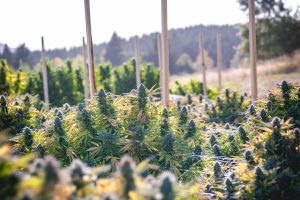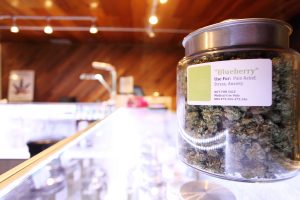Oklahoma Bar Journal
Oklahoma’s Newest Crop
By Rachel L. Bussett
 Legalized cannabis[1] burst onto Oklahoma’s agricultural landscape when the polls closed at 7 p.m. on June 26, 2018. Like homesteaders taking off at high noon on April 22, 1889, building cities overnight on the prairie, cannabis businesses popped up on every corner as the program was up and running in 60 days with little oversight and regulation. Now, nearly seven years later, we are still working out the place medical cannabis has in Oklahoma and the best means of regulation. Cannabis has quickly become one of Oklahoma’s largest cash crops and has brought millions of new dollars into the economy since legalization.
Legalized cannabis[1] burst onto Oklahoma’s agricultural landscape when the polls closed at 7 p.m. on June 26, 2018. Like homesteaders taking off at high noon on April 22, 1889, building cities overnight on the prairie, cannabis businesses popped up on every corner as the program was up and running in 60 days with little oversight and regulation. Now, nearly seven years later, we are still working out the place medical cannabis has in Oklahoma and the best means of regulation. Cannabis has quickly become one of Oklahoma’s largest cash crops and has brought millions of new dollars into the economy since legalization.
CANNABIS AS AN AGRICULTURE CROP
Simply defined, agriculture is the art and science of the cultivation of soil for the raising of crops and livestock.[2] The U.S. Department of Agriculture defines horticulture as a branch of “agriculture concerned with growing plants that are used by people for food, for medicinal purposes, and for aesthetic gratification.”[3] Crops are “plants that are cultivated either for sale or for subsistence.”[4] Oklahoma law defines horticulture as “agriculture science relating to the cultivation of gardens or orchards, including, but not limited to the growing of vegetables, flowers, and ornamental trees and shrubs.”[5]
Oklahoma’s medical marijuana program is focused on cultivating, processing and distributing the plant “cannabis sativa” for use as medicine as defined in Title 63 of the Oklahoma Statutes.[6] Therefore, cultivating, growing and processing cannabis, aka “medical marijuana,” is agriculture under the law, even though many in the legal system may not want to recognize its role as an agricultural crop.
A SHIFTING LEGAL LANDSCAPE
As of Feb. 11, 2025, 24 states, Guam, the Northern Mariana Islands and the U.S. Virgin Islands have legalized “adult use” or “recreational use” of cannabis.[7] Six states – Hawaii, Indiana, Kentucky, New Hampshire, Tennessee and Texas – have live proposed bills for adult-use cannabis.[8] Bills are also pending in Alabama, Iowa, Pennsylvania, South Carolina and Wyoming that would decriminalize or remove possible jail time for simple possession.[9]
Thirty-nine states – along with Washington, D.C., and the U.S. territories of Guam, the Northern Mariana Islands, Puerto Rico and the U.S. Virgin Islands – have medical programs, with bills pending in Indiana, Iowa, South Carolina, Tennessee and Texas for medical cannabis.[10] If the pending bills pass in Iowa, South Carolina and Wyoming, then Kansas would be the only state with no level of legalized cannabis use or possession.[11]
For years, marijuana has been defined as an addictive substance, and it is listed as a Schedule I drug. According to the Drug Enforcement Administration (DEA), a Schedule I drug is one that has no currently accepted medical use and has a high potential for abuse.[12] Cannabis, like any drug (legal or illegal) – including sugar, caffeine and nicotine – has the potential for misuse and abuse.
On Aug. 30, 2023, the U.S. Department of Health and Human Services reported it was recommending that cannabis be lowered to Schedule III from Schedule I under the Controlled Substances Act.[13] This is a follow-up to a recommendation by President Biden in October 2022 that the scheduling for cannabis be reviewed. For this change to be made, the U.S. Food and Drug Administration (FDA) must make findings and recommendations to the DEA, which is overseen by the U.S. Department of Justice (DOJ). The DEA and the DOJ, utilizing scientific and medical data on the efficacy of cannabis, must make findings that the evidence supports and fits into the defining criteria for the appropriate schedule, and then the change is made.[14]
The expected rescheduling of cannabis did not occur before President Biden left office. Instead, there is much speculation about what will occur under the second Trump administration. President Trump has recently spoken out in favor of cannabis rescheduling, but newly appointed Attorney General Pam Bondi has previously opposed medical cannabis legalization and has supported smoking bans.[15]
The rescheduling of cannabis not only carries significant legal implications for those who use it but also significant financial implications for businesses across the country. Once it is rescheduled, Internal Revenue Code 280E, which significantly limits the ability of businesses to deduct otherwise legitimate business expenses, will no longer act as a barrier to entry into the market of legal cannabis enterprises unless a special tax is imposed.[16] Additionally, once cannabis is legalized at the national level, this local trade will be legal internationally. Leading cannabis law firms believe that rescheduling will actually put the U.S. in a better position to comply with its international treaty obligations.[17]
Scheduling determinations are based upon a drug’s associated risk for abuse along with its potential medical use and benefits, overall knowledge of the drug, risk to public health, potential for alteration or modification to increase associated risk and trend in drug usage.[18] A Schedule III drug has a “potential for abuse less than the drugs or other substances in schedules I and II;” “has a currently accepted medical use in treatment in the United States;” and is one where the potential for abuse is “moderate or low [for] physical dependence or high [for] psychological dependence” on the drug.[19] In previous congressional hearings, the DEA has indicated that it will be bound by the recommendations of the FDA.[20]
This is important because there is significant scientific data behind the medical use of cannabis. Cannabis has been studied for specific health conditions, such as pain, reduction of opioid use, anxiety, epilepsy, glaucoma, HIV/AIDS, inflammatory bowel disease, irritable bowel syndrome, movement disorders related to Tourette syndrome, multiple sclerosis, nausea and vomiting related to cancer chemotherapy, PTSD and sleep apnea, to name a few conditions.[21] [22] [23] There are multiple FDA-approved drugs using cannabinoids and/or synthetic THC. These are Marinol,[24] Syndros,[25] Cesamet,[26] Epidiolex,[27] dronabinol and nabilone.[28] This data is often ignored because the definition of a Schedule I drug fundamentally conflicts with it having medical usage. The approval of these cannabinoid/THC-based medications underscores the impact rescheduling will have while still allowing for compliance with our wider international treaty obligations.[29] However, recognition of this research and the impact of legalization on the wider international community takes us back to the basic concept of this article: Cannabis is and remains an agricultural and horticultural crop cultivated for food and/or medicinal purposes and has been throughout history.
HISTORICAL SIGNIFICANCE AND MEDICAL APPLICATIONS
 History shows that cannabis has been cultivated for usage as food, medicine and materials throughout time. It was significant in the early colonization of the United States. Evidence even suggests it was brought to the Americas in 1492 by explorer Christopher Columbus with the hemp ropes on his ships.[30] In the 1600s, when the Jamestown Settlement was established, the colonists were required to grow cannabis, as it was an important crop to the English crown.[31] Cannabis was one of three primary crops grown by George Washington at his Mount Vernon plantation.[32] It was also grown by Thomas Jefferson.[33] Cannabis was grown for fiber, medicine and feed for livestock prior to delegalization. Rescheduling cannabis to Schedule III has the potential to allow the full use of the plant to positively impact animals and humans.
History shows that cannabis has been cultivated for usage as food, medicine and materials throughout time. It was significant in the early colonization of the United States. Evidence even suggests it was brought to the Americas in 1492 by explorer Christopher Columbus with the hemp ropes on his ships.[30] In the 1600s, when the Jamestown Settlement was established, the colonists were required to grow cannabis, as it was an important crop to the English crown.[31] Cannabis was one of three primary crops grown by George Washington at his Mount Vernon plantation.[32] It was also grown by Thomas Jefferson.[33] Cannabis was grown for fiber, medicine and feed for livestock prior to delegalization. Rescheduling cannabis to Schedule III has the potential to allow the full use of the plant to positively impact animals and humans.
In the 20th century, researchers discovered the endocannabinoid system. In 1988, researchers working at Saint Louis University discovered cannabinoid receptors, the most abundant neurotransmitters in the human brain.[34] In 1990, the DNA sequence for these receptors was mapped. These findings led to the discovery of endocannabinoids and the endocannabinoid system (ECS).[35] The ECS is found in all vertebrates and contributes to the maintenance of homeostasis in the body to help regulate sleep, mood, appetite, memory, reproduction and fertility.[36] It impacts our immune, endocrine, nervous and reproductive systems.
While doctors are still trying to fully understand how the ECS works in our bodies, we do know the plant-based cannabinoids in cannabis and all cannabinoid-containing foods bind to our CB1 and CB2 receptors to allow our bodies to operate at optimum capacity.[37] The ECS is made up of CB1 and CB2 receptors. CB1 receptors are mainly found in our central nervous system. CB2 receptors are mainly found in our peripheral nervous system and immune system.
Endocannabinoids are substances our bodies make naturally to stimulate the receptors in the ECS. Phytocannabinoids are chemicals found in plants like cannabis, sunflower, echinacea, black pepper, black truffle, cacao, kava, electric daisy, Japanese liverwort, rhododendron and tea plants.[38]
Two major endocannabinoids are made within our bodies on demand when needed: anandamide and 2-arachidonoylglycerol (2-AG). Anandamide is our body’s bliss molecule, and it bonds to the CB1 receptors.[39] This is the same receptor THC bonds to within the body. 2-AG is the most prevalent endocannabinoid in the human body, and it plays a significant role in anti-inflammation through immunosuppression, similar to how steroids work. It also acts in a psychoactive manner when binding to the CB1 receptor, though it binds to both the CB1 and CB2 receptors.
An article on male reproductive health and infertility noted: “Recent research has documented that a variety of human disorders are accompanied by dysfunction in the ECS; therefore, pharmacological interventions that normalize dysfunctional ECB signaling, i.e. temporally activating CB receptors by THC could be potential therapeutics for diseases associated with hypo-cannabinergic pathology.”[40] Another article, published on Feb. 3, recognized that the ECS “plays a fundamental role in the physiology and pathology of the gastrointestinal tract, particularly in the small and large intestine and liver.”[41] This begs the question, “Is there a medical reason, even potentially a healthful reason, that the munchies are associated with cannabis consumption?” Further research is needed, but the correlation between cannabis usage and the improvement in appetite was one of the early arguments for medical legalization and is what brought us to this path.
CBD and Delta-9 THC are generally the most predominant cannabinoids in cannabis, and CBD affects the way Delta-9 THC interacts with the CB1 receptors.[42] Further, as cannabis flower ages with time and exposure to oxygen, THC breaks down into cannabinol (CBN). CBN has been determined to be an effective sleep aid, pain reliever and immune system booster.[43] So far, 113 different cannabinoids and 120 terpenes have been identified in cannabis.[44]
Terpenes are the aromatic compounds in all plants, whether it’s cannabis, a flower, a fruit or a vegetable.[45] The combination of terpenes gives each plant its unique scent. When cannabinoids and terpenes are consumed together in cannabis, they cause the user to experience what is called the “entourage effect.” The entourage effect is the synergistic effect of consuming all the compounds in the cannabis plant.[46]
Hemp/cannabis is considered a superfood for its nutritive value.[47] Hemp seeds are rich in protein, fiber, omega-3s and 6s fatty acids, minerals and vitamins, along with antioxidant effects.[48] All of this is consumed without psychoactive effects. We can look at this to understand the interplay of terpenes and cannabinoids in consumption. In explaining this synergistic interplay, it is easiest to compare terpenes to essential oils and cannabinoids to vitamins and minerals. This is a very simplistic metaphor, but it helps people understand the principles of the compounds and how they work as medicine in a plant. For many years, it has been the trend to treat everything from insomnia to indigestion with an essential oil. Further, we know the vitamins and minerals we ingest have an overall impact on our immune systems and general health and well-being. Terpenes are found in all plants, so we already consume them, and cannabinoids are also found in many commonly consumed plants, as discussed earlier.
Initially, terpenes were believed to simply enhance the experience of cannabis consumption through the smell of the flower before smoking.[49] Incidentally, many people do not understand that it is the flower of the cannabis plant that is primarily smoked or consumed, not the leaves. However, research indicates that terpenes may contribute to the overall medical benefit of cannabis consumption.
Linalool is the terpene in lavender that makes us feel relaxed.[50] Linalool is also antimicrobial, antibacterial, antifungal, anxiety-reducing and an immune booster. Limonene is the terpene found in citrus fruits that makes us feel energized. It’s also an antimicrobial, antibacterial, anti-inflammatory and antianxiety agent.[51] Eucalyptol is found in eucalyptus and helps open bronchial passages.[52] It is also antibacterial and anti-inflammatory and has been found to kill certain cancer cells. Myrcene is a terpene prevalent in hops, lemongrass, verbena, bay and citrus fruits and juices.[53] Myrcene has properties that are analgesic, sedative, antidiabetic, antioxidant, anti-inflammatory and antibacterial, as well as having anticancer effects. Caryophyllene is found in clove, rosemary, black pepper and lavender. It is shown to have anticancer and anti-inflammatory properties and to help with sleep, anxiety and depression. All of these terpenes are also commonly found in cannabis.[54] These are just three of the many terpenes that are in cannabis and other plants.
Cannabis comes in many different “flavors” or “cultivars,” with fancy names developed using plant genetics to create plant-based medicine through the combination and concentration of specific terpenes and cannabinoids in the plant. It is these various combinations that pharmaceutical companies cannot reproduce in labs that make cannabis so unique as an agricultural product and show the importance of food as medicine.
CONCLUSION
Medical marijuana is presently the law in Oklahoma. As practitioners, it should benefit us and our clients to continue reviewing the science and research being conducted as medical marijuana becomes more generally accepted. As research continues, the law may evolve further.
 ABOUT THE AUTHOR
ABOUT THE AUTHOR
Rachel L. Bussett owns and practices at Bussett Legal Group, an all-female firm in Oklahoma City that heavily focuses on cannabis law. She is a trial attorney with a national practice focused on civil and human rights and personal injury. Ms. Bussett enjoys spending time with her husband, four daughters and three dogs.
ENDNOTES
[1] While the article is titled “Oklahoma’s Newest Crop,” it will be referred to as cannabis for this article. The term “marijuana” came into common usage in the early 1900s due to the Mexican Revolution and the influx of immigrants into the U.S. who used cannabis.
[2] https://bit.ly/4cjTu0U.
[3] https://bit.ly/3OCtVxk.
[4] https://bit.ly/3SRTzk6.
[5] 2 O.S. §3-32.1.
[6] 63 O.S. §427.3.
[7] https://bit.ly/42nBDl9.
[8] Id.
[9] Id.
[10] Id.
[11] Id. See also https://disa.com/marijuana-legality-by-state.
[12] https://bit.ly/3ulf8Aq.
[13] https://bit.ly/3SCdL8B.
[14] 21 USC 811(a)(1)(B).
[15] https://bit.ly/3RxPBvw.
[16] https://bit.ly/44f9Ndh.
[17] https://bit.ly/4jnHuOh.
[18] www.ncbi.nlm.nih.gov/books/NBK557426.
[19] 21 USC §812.
[20] https://bit.ly/3StTqSG.
[21] https://bit.ly/3SCQsv0.
[22] https://bit.ly/3urRTog. “Phytocannabinoids: General Aspects and Pharmacological Potential in Neurodegenerative Diseases.”
[23] https://bit.ly/3ulfib0. “Therapeutic Effects of Cannabis and Cannabinoids.”
[24] https://bit.ly/3ujGzKZ.
[25] https://bit.ly/48dn8kO.
[26] https://bit.ly/3Uwl3xb.
[27] https://bit.ly/3ujGG9n.
[28] https://bit.ly/42GRvyP.
[29] https://bit.ly/4jnHuOh.
[30] https://bit.ly/499LtJk.
[31] https://bit.ly/3UB5Nip, citing Ernest Abel, Marihuana: The First Twelve Thousand Years.
[32] https://bit.ly/499LtJk.
[33] Id.
[34] https://bit.ly/48b05qL.
[35] Id.
[36] https://bit.ly/3wdtyDf.
[37] https://bit.ly/49e9dMz.
[38] https://bit.ly/3OEepAW.
[39] https://bit.ly/48hLJ7P.
[40] https://bit.ly/3SCdX7P, internal citations omitted.
[41] https://bit.ly/3YhN4JH.
[42] https://bit.ly/3upSTcz.
[43] https://bit.ly/3uDAzfU.
[44] https://bit.ly/3OD5L5O.
[45] www.sciencedirect.com/topics/chemistry/terpene.
[46] https://bit.ly/3ODIH75.
[47] https://bit.ly/3STpYXB. “A Review of Hemp as Food and Nutritional Supplement.”
[48] https://bit.ly/3SWBSjK.
[49] https://bit.ly/3UCTe6e.
[50] Id.
[51] https://bit.ly/3SCeh6x.
[52] http://terpene.info/terpene/eucalyptol.
[53] https://bit.ly/3SRUe54.
[54] https://bit.ly/3ODIH75.
Originally published in the Oklahoma Bar Journal – OBJ 96 No. 5 (May 2025)
Statements or opinions expressed in the Oklahoma Bar Journal are those of the authors and do not necessarily reflect those of the Oklahoma Bar Association, its officers, Board of Governors, Board of Editors or staff.
